Panasonic of North America 9TGCF-291A Panasonic Toughbook w/ WLAN User Manual 29MK3 X E OI COVER PM6
Panasonic Corporation of North America Panasonic Toughbook w/ WLAN 29MK3 X E OI COVER PM6
Contents
- 1. Users Manual 1
- 2. Users Manual 2
- 3. Users Manual 3
Users Manual 2
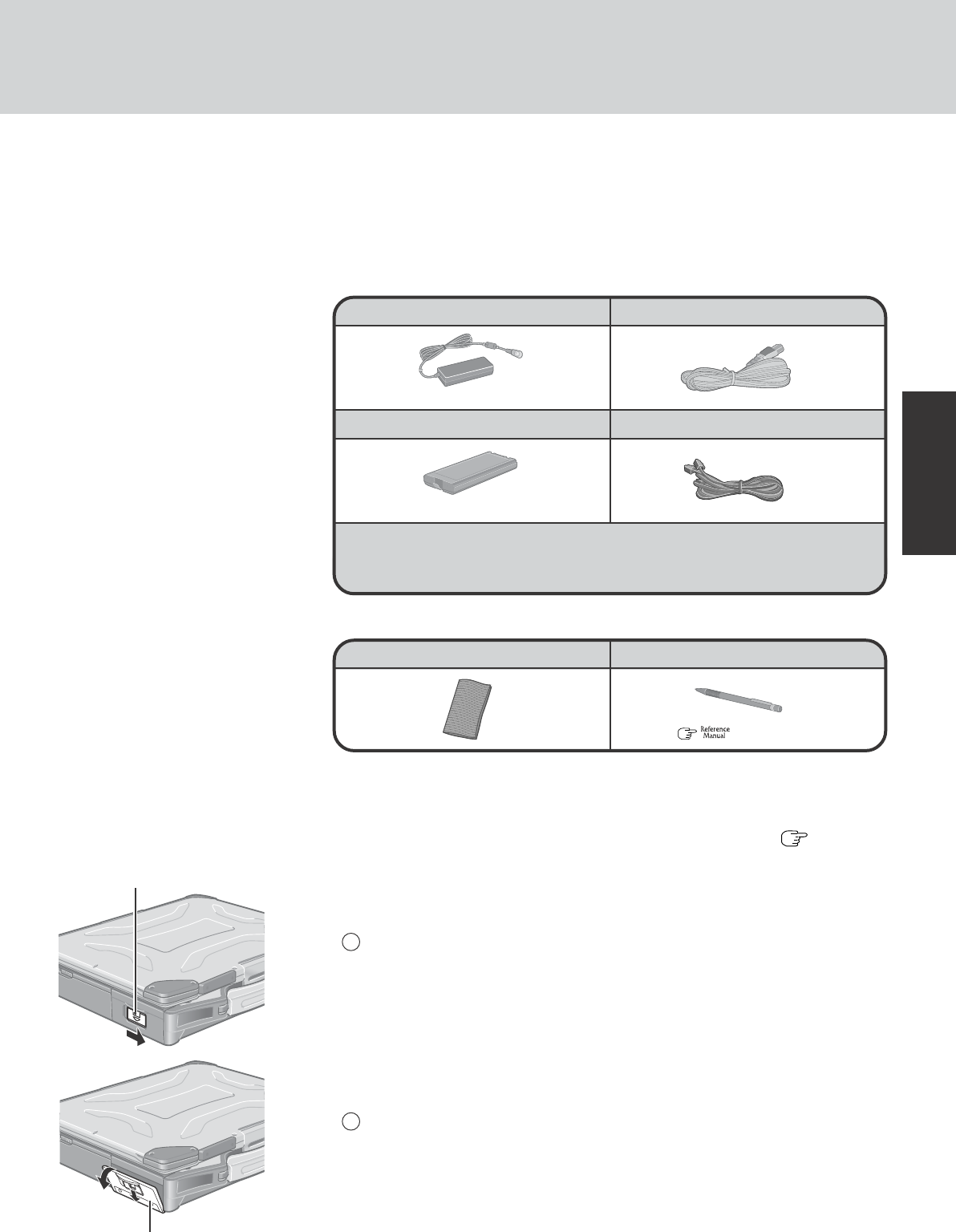
11
Getting Started
2Read the LIMITED USE LICENSE AGREEMENT. ( page 35)
Be sure to read the LIMITED USE LICENSE AGREEMENT before breaking the seal
on the computer’s packaging.
3Insert the battery pack.
1Unlock the cover by sliding the latch to the right.
First-time Operation
Read the steps below to help you learn what parts are included, and to gain an understanding of
some basic computer-related operations.
1Confirm the inclusion of all parts.
Make sure the parts shown in the figure have been supplied. If any of these items are
missing or are not working properly, contact Panasonic Technical Support.
Model No : CF-AA1653A
Model No : CF-VZSU29
Operating Instructions (This book)*1.......................................................... 1
Windows® Book ...................................................................................... 1
Product Recovery CD-ROM ................................................................... 3
( “Touchscreen”)
Soft Cloth .................................. 1 Stylus ..................................... 1
<Only for models with touchscreen>
Battery Pack .............................. 1 Modem Telephone Cable .......... 1
AC Adaptor................................ 1 AC Cord ..................................... 1
Latch
Cover
*1If additional instructions are included with the computer, be sure to read them. It may be neces-
sary to perform additional operations during the following procedures.
2Slide the latch down, and then without releasing it, open the cover as illustrated.
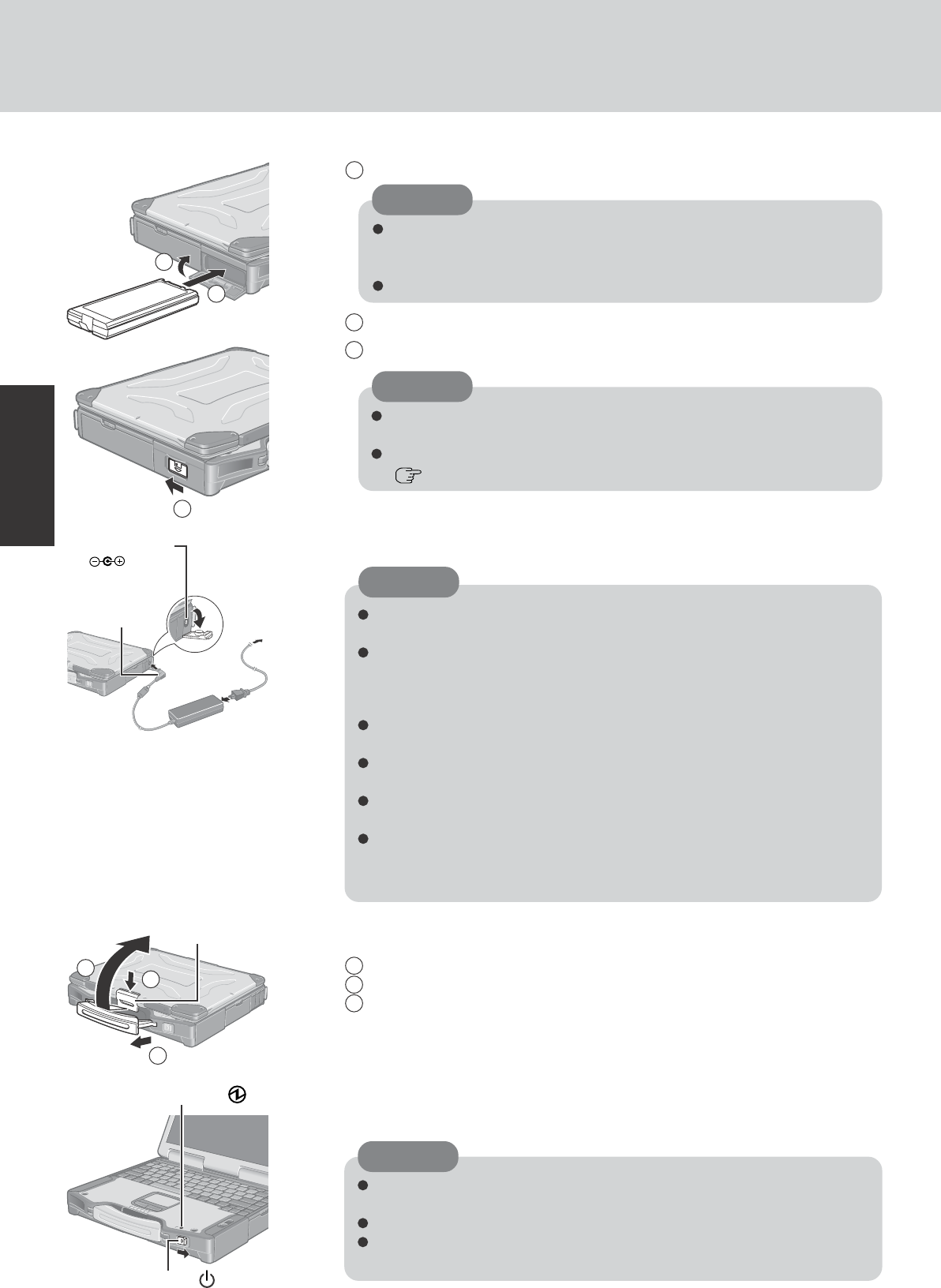
12
Getting Started
First-time Operation
6Turn your computer on.
Slide the power switch and hold it for approximately one second until the power indi-
cator turns on before releasing it.
Do not slide the power switch and hold it for more than four seconds; this will
cause the power to be turned off forcibly.
Do not slide the power switch repeatedly.
Once the computer is powered off, you must wait at least ten seconds before
powering it on again.
4Connect your computer to a power outlet.
Be sure the AC adaptor is connected until completing the first-time use opera-
tion.
When using the computer for the first time, do not connect any peripheral de-
vice except the battery pack and AC adaptor to the computer.
Handling the AC adaptor
Do not twist or pull the AC power cord forcefully. Doing so may damage the
connections.
Use only the specified AC adaptor with your computer. Using an AC adaptor
other than the one supplied might damage the battery and/or the computer.
When the DC plug is not connected to the computer, disconnect the AC cord
from your AC wall outlet.
Problems such as sudden voltage drops may arise during periods of thunder and
lightning. Since this could adversely affect your computer, an uninterruptible
power source (UPS) is highly recommended unless the battery pack is installed.
Power Indicator
CAUTION
CAUTION
5Open the display.
1Pull the carrying handle forward.
2Press the latch as illustrated.
3Lift up the latch and open the display.
CAUTION
Do not touch the terminals on the battery pack and the computer. The battery
pack may no longer function properly if the contacts are dirty or damaged.
Also, the computer may not operate properly.
Be sure to insert the battery pack as illustrated.
3Slide the battery pack inward until it is firmly in place.
4Close the cover until it clicks into place.
5Lock the cover by sliding the latch to the left.
CAUTION
Confirm that the latch lock is correctly in place. If you carry your computer
without the latch lock in place, the battery pack may fall out.
Before using the battery pack, carefully read “Precautions (Battery Pack)”
( page 7-8).
DC-IN Jack
DC IN 15.6 V
DC Plug
Power Switch
3
4
1
2
3
Latch
POWER
5

13
Getting Started
7Setup Windows.
Moving the cursor ( ) or clicking buttons can be performed with the touch pad.
The touchscreen does not work properly during the Windows setup.
NOTE
Select settings for your region, then select [Next].
4Enter your name and organization and then select [Next].
5Enter your computer name and administrator password and then select [Next].
Do not press any keys or touch the touch pad until [Windows XP Professional
Setup] is displayed.
CAUTION
1At [Welcome to the Windows XP Setup Wizard], select [Next].
2After reading the agreement, select [I accept this agreement] or [I don’t accept this
agreement], then select [Next].
NOTE
If [I don’t accept this agreement] is selected, the Windows setup will be aborted.
3
CAUTION
Remember this password! If the password is forgotten, Windows cannot be
operated.
6Enter the correct date, time and time zone, then select [Next].
The computer will restart.
7Enter your administrator password and select .
Wait until the hard disk drive indicator ( ) has turned off.
NOTE
8<Only for models with touchscreen>
Calibrate the touchscreen.
1Select [start] - [Control Panel] - [Printers and Other Hardware] - [Mouse] -
[TouchScreen] - [Calibration].
2Touch the “+” mark on the calibration screen with the stylus (included) for about one
second.
3After the calibration procedure is executed (e.g., after the nine “+” marks are touched),
the procedure ends when Enter is pressed.
4Select [OK].
It may take some time before the computer restarts and the screen of step 7 is
displayed. Wait, and do not press any keys, or touch the touch pad, etc.
NOTE
When Windows setup is completed, the following message will be displayed at
the bottom right of the screen: “Your computer might be at risk.” Continue to
the next step.
The message is generated by the [Security Center] function in [Control Panel],
and does not indicate an error or malfunction. For more information about [Se-
curity Center]: page 22.
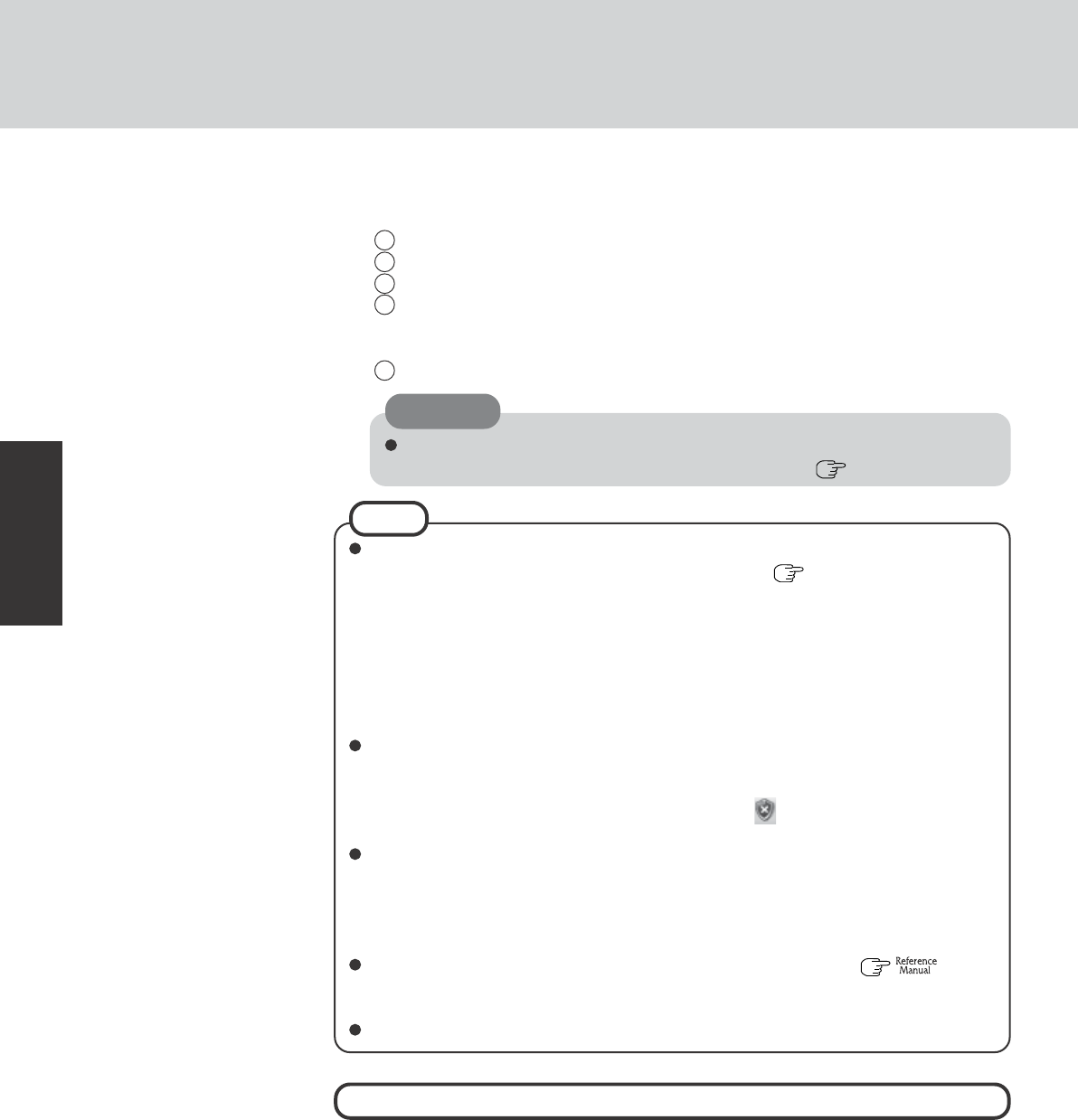
14
Getting Started
This concludes the first-time use operation guidelines.
9Create a new account.
CAUTION
Remember this password! If the password is forgotten, Windows cannot be oper-
ated. You can create a password reset disk beforehand ( page 15).
When creating a new user account:
• If you make mail settings, create password reset disks ( page 15), or conduct other
related operations before creating the user account, you will be unable to use any pre-
vious mail history or settings.
• When you create the first new account, you can only select [Computer administrator].
Once a “Computer Administrator” account has been created, you can create additional
limited user accounts.
Note also that only the added user account will be displayed in the Welcome screen.
The account for the administrator created during Windows setup will not be displayed.
The message “Your computer might be at risk,” which is displayed at the bottom right of
the screen, is generated by the “Security Center” function in Windows XP, and does not
indicate an error or malfunction.
To prevent this message from being displayed, select (red icon) on the taskbar, then
select [Turn on Automatic Updates].
About the Icon Enlarger:
• If the characters or icons on the screen are too small and difficult to see, after complet-
ing step 9, select [start] - [All Programs] - [Panasonic] - [Icon Enlarger]. This will
allow you to magnify the display of characters and icons on the screen.
• The [Icon Enlarger] can be set separately for each account.
You can also use [Loupe Utility], which enlarges a part of the screen.( “Loupe
Utility”)
<Only for models with wireless LAN>
If you use the wireless LAN, be sure to refer to the Reference Manual’s “Wireless LAN”.
NOTE
First-time Operation
1Select [start] - [Control Panel] - [User Accounts] - [Create a new account].
2Enter a name for the new account, then select [Next].
3Select [Computer administrator], then select [Create Account].
4<When you want to create a password for the new account>
Select the new account you have created and select [Create a password].
Follow the instructions on the screen to create a password.
5Select [start] - [Turn Off Computer] - [Restart] to restart the computer.

15
Getting Started
Information for Windows XP
Depending on the Windows settings, installed applications, and drivers, menus and other
displays may differ, or some functions (such as use of the password reset disk) may be inop-
erable. Check with your system administrator for details.
You can select Classic view for the Control Panel or select the Classic Start menu. You can
also change the way a user logs on or off.
The procedure in this manual uses the method or view of the Windows XP default setting
(not Classic view or Classic Start menu etc.).
Resetting the password
Windows XP has a function to reset a forgotten password.
To use this function, you need to create a password reset disk beforehand following the steps
below.
1Select [start] - [Control Panel] - [User Accounts].
2Select [Prevent a forgotten password] from the [Related Tasks] menu of the account you
have logged on to, and create a password reset disk following the on-screen instructions.
Store the password reset disk in a safe place.
• Only the logon password for each account can be reset.
The password set in the Setup Utility ( “Setup Utility”) cannot be reset.
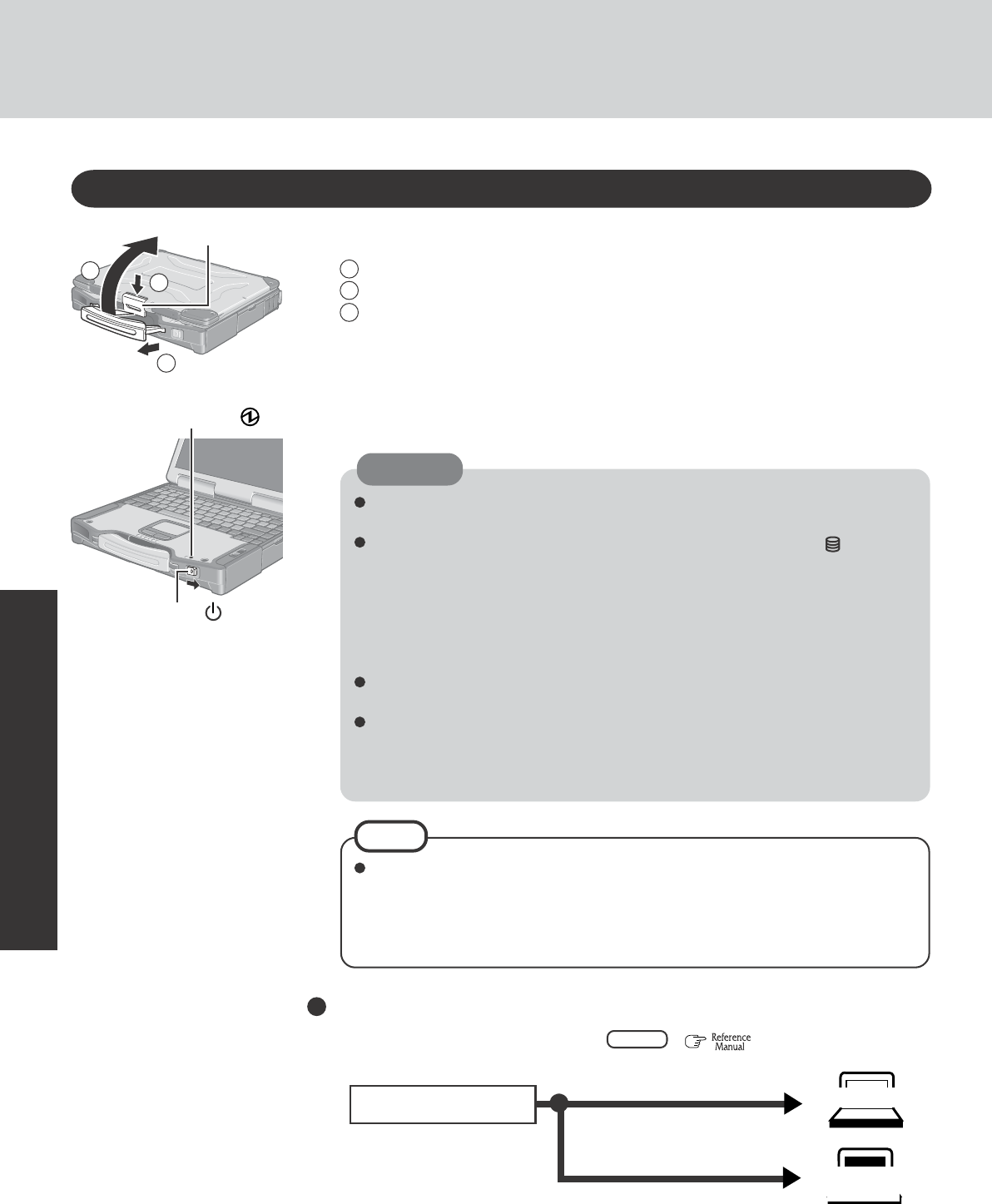
16
Operation
1Open the display.
Starting Up/Shutting Down
Starting Up
2Turn your computer on.
Slide the power switch and hold it for approximately one second until the power indicator
turns on before releasing it.
Under the condition that both the AC adaptor and the port replicator are not con-
nected, the power will not go on if the display is closed.
While booting, avoid the following until the hard disk drive indicator ( ) has turned
off.
• Connecting or disconnecting the AC adaptor.
• Touching the power switch.
• Performing any keyboard, touch pad, touchscreen (only for models with touch-
screen), or external mouse operations.
• Closing the display.
Once the computer is powered off, you must wait at least ten seconds before pow-
ering it on again.
When the CPU temperature rises, the computer may not power on to prevent the
CPU from overheating. Should this happen, allow the computer to cool down then
switch the power on again.
If the computer still does not power on, contact Panasonic Technical Support.
CAUTION
1Pull the carrying handle forward.
2Press the latch as illustrated.
3Lift up the latch and open the display.
Power Indicator
Power Switch
1
2
3
Latch
Three incorrect attempts
or
No password for about a minute
The correct password Will Start
Enter your password*1 and press Enter . ( “Security Measures”)
Will Not Start
(Power off)
If [Enter Password] is displayed
*1Supervisor Password or User Password set in the Setup Utility (not
the Windows password).
Enter Password [ ]
POWER
When the power is turned on in a low-temperature environment, sometimes the
message “Warming up the system. Please wait...” is displayed (up to 20 minutes) or
the battery indicator alternately blinks green and orange. This function is designed
to prevent hard disk drive malfunctions that may occur at low temperatures. Wait
for the computer to start up.
NOTE
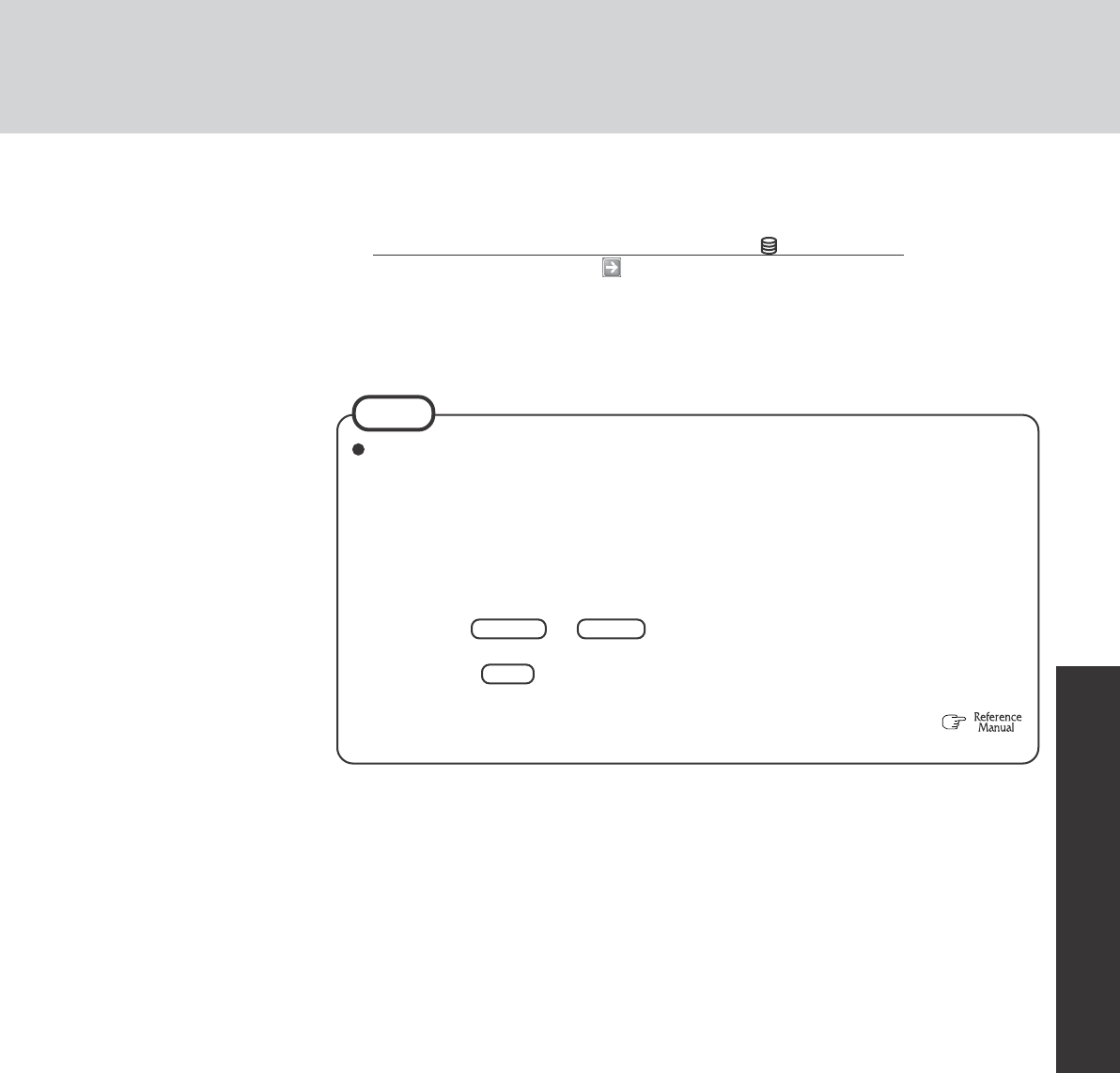
17
Operation
The power saving function is factory set, so if there is no input from a key, the touch pad,
the touchscreen (only for models with touchscreen) or an external mouse (when one is
connected) for a certain interval of time, the power to the LCD and hard disk may be
turned off. The LCD will resume operation when the touch pad, the touchscreen (only
for models with touchscreen) or an external mouse (when one is connected) is used or a
key is pressed.
The power to the LCD may be turned off even when an application software is being
installed. In this case, because it is conceivable that a selection dialog box will be shown,
do not press Space or Enter to attempt to resume from this condition as doing
so may trigger a selection, but instead, press a key unrelated to the direct triggering of a
selection, like Ctrl .
In addition, when the computer is left alone, it automatically enters the standby or hiber-
nation mode. The computer will resume by sliding the power switch. (
“Standby/Hibernation Functions”)
NOTE
3Log on to Windows.
After confirming that the hard disk drive indicator ( ) has turned off, select the user and
input the password, then select . Until the correct password is entered, the computer will
not operate.
4Select your application.
You are able to start working on your computer.
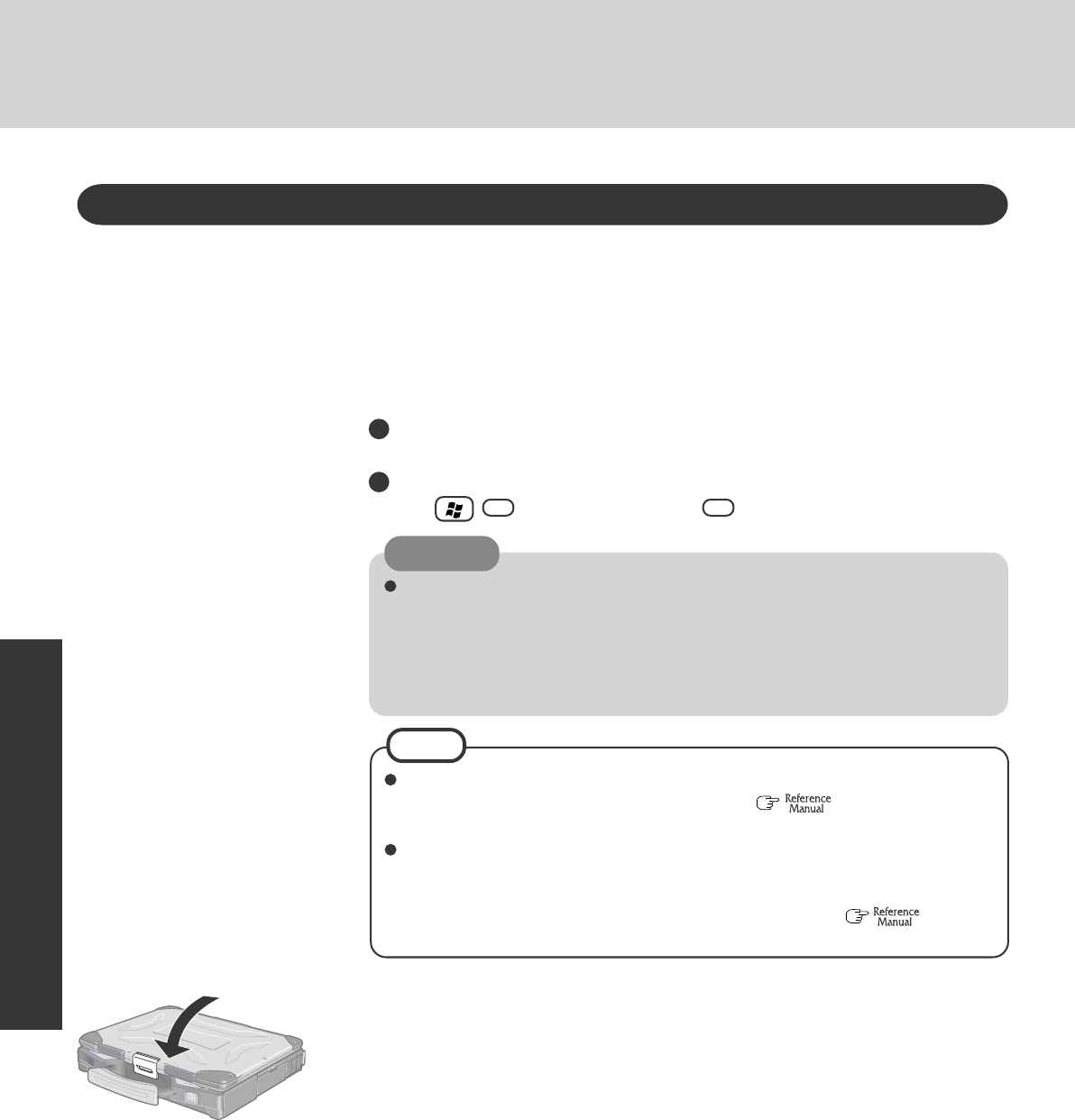
18
Operation
Shutting Down (power off your computer)
To quickly resume computer operation after shutting down,
The standby or hibernation function is available ( “Standby/Hibernation
Functions”).
When you leave the computer or interrupt your work...
If you use the “Standby” or “Hibernation” function, then when you turn on the
power next time, the application software and files you were using before will be
displayed, and you can restart the same operations immediately ( “Standby/
Hibernation Functions”).
NOTE
1Save important data and close each application.
2Select [start] - [Turn Off Computer].
3Select [Turn Off].
Your computer will power off automatically.
Restarting your computer (without shutting down)
Select [Restart].
To shut down using the keyboard;
Press , U , and select [Turn Off] with U .
CAUTION
Do not do the following during the shutdown/restart procedure.
• Connecting or disconnecting the AC adaptor.
• Touching the power switch.
• Performing any keyboard, touch pad, touchscreen (only for models with touch-
screen), or external mouse operations.
• Closing the display.
4Close the display until the latch clicks into place.
Starting Up/Shutting Down
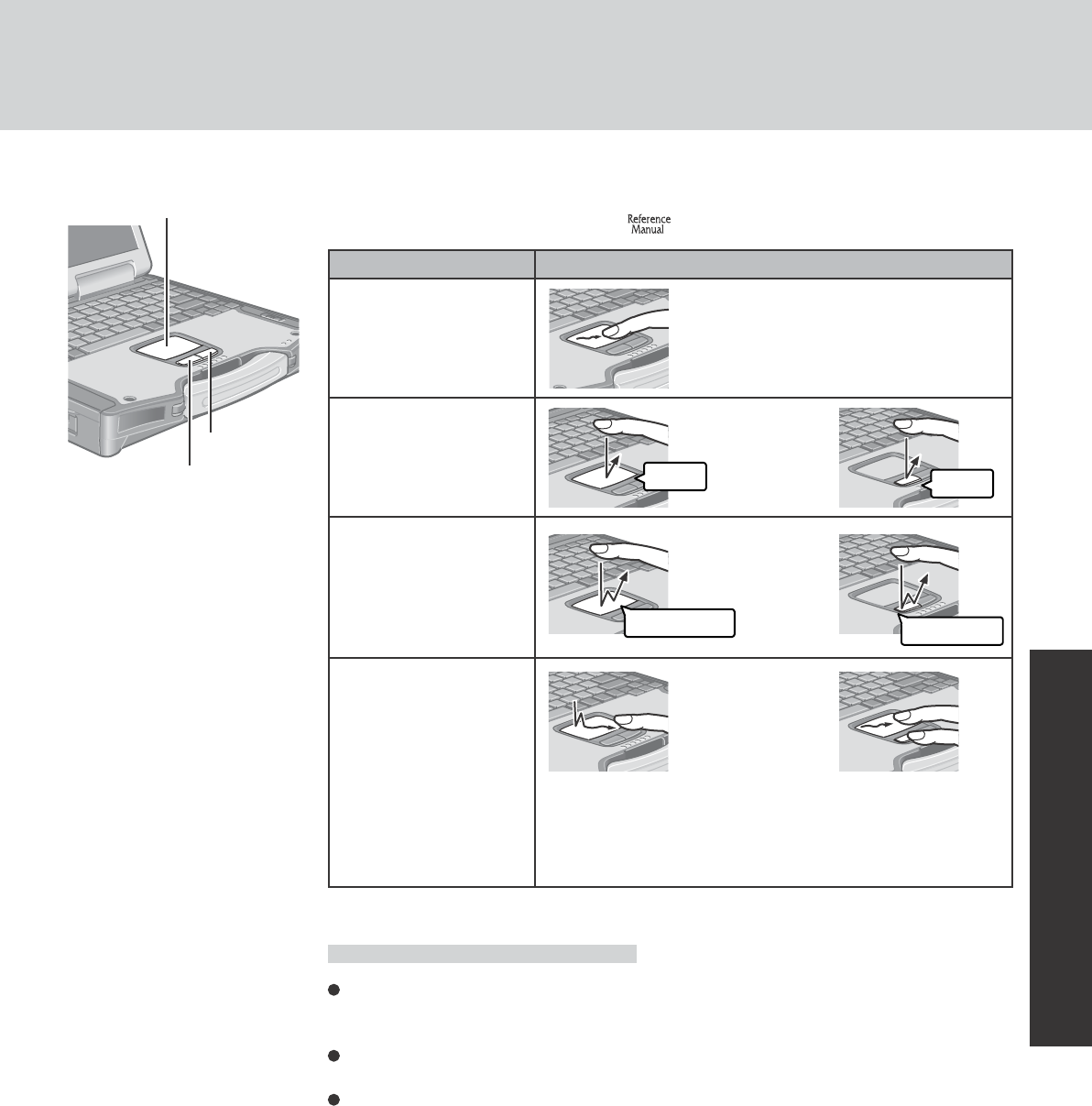
19
Operation
Function
Touch Pad (Basic Operation)
Use the touch pad to move the cursor on the screen and perform computer operations. For
instructions on how to operate, refer to “Touch Pad”.
By design the touch pad is to be used with a finger tip only. Do not place any object on the
work surface or press down forcefully with sharp-pointed objects (e.g., nails) or hard ob-
jects that can leave marks (e.g., pencils and ball point pen).
Try to avoid having any harmful substances such as oil, come in contact with the touch pad.
The cursor may not work properly in such cases.
When the touch pad becomes dirty:
Wipe to remove dirt by using a dry soft cloth such as gauze or a soft cloth first applied with
detergent diluted with water and then thoroughly wrung.
Do not use benzene, thinner, or rubbing alcohol. Doing so may adversely affect the surface,
e.g., discoloration. In addition, do not use commercially-available household cleaners and
cosmetics, as they may contain components harmful to the surface.
or
Two quick taps, but on the
second tap leaving your
finger down (applying
pressure) and moving it on
the work surface.
While holding down
the button, moving
your finger on the
work surface.
or
Touch Pad Operation
Moving the Cursor
Tapping/Clicking
Double-Tapping/
Double-Clicking
Dragging
or
Move the tip of your finger lightly over
the surface.
tapping clicking
double-clicking
Handling the Touch Pad
Left Button
Right Button
Work Surface
double-tapping
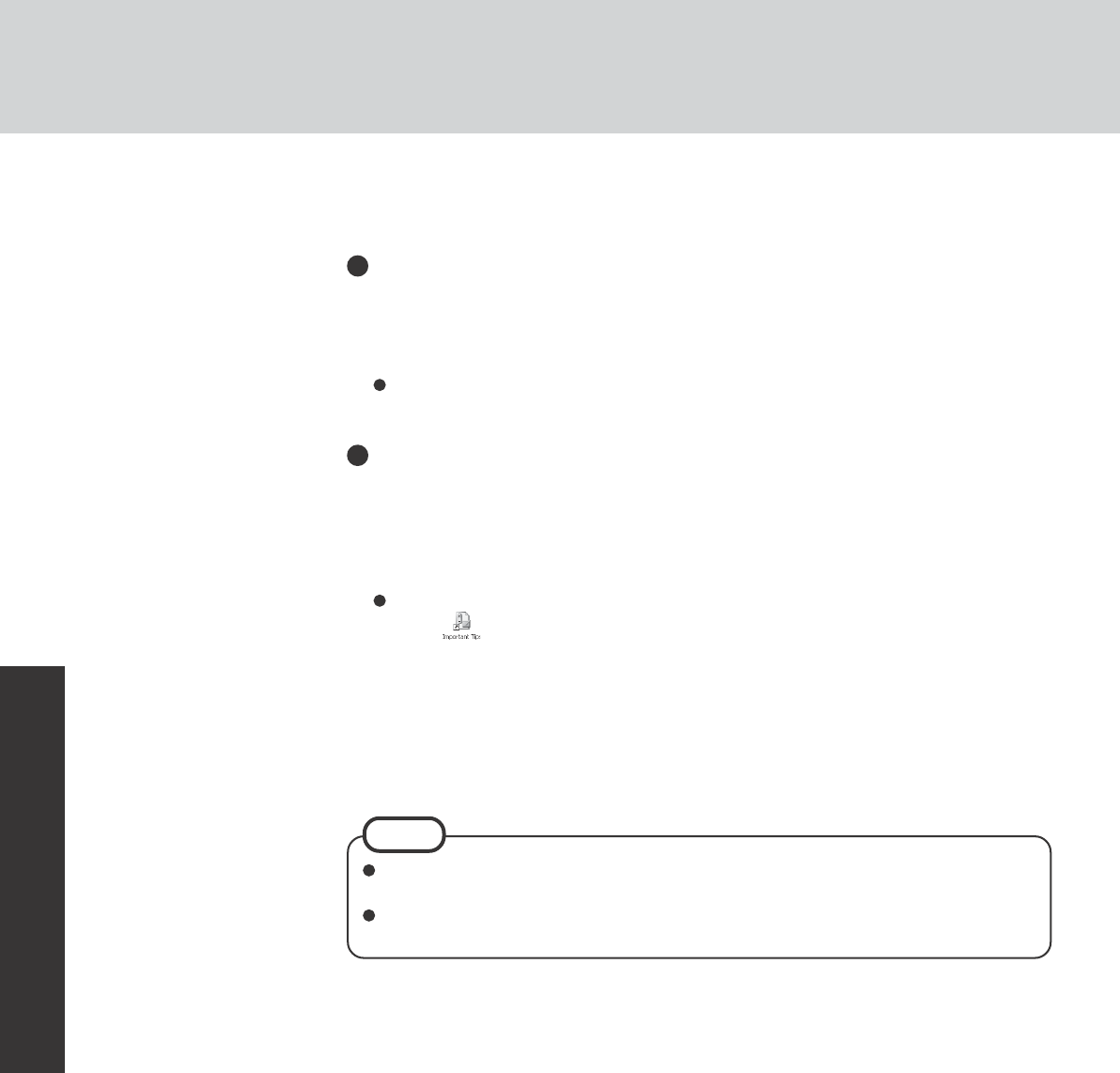
20
Operation
Reference Manual
Illustrations may be difficult to view depending on the magnification. If the illustration
is too small, magnify the display.
If a printer is connected, we recommend printing the pages required. The illustrations
and display samples may not be printed with a high quality.
NOTE
The Reference Manual and the Important Tips can be accessed on your computer. When a
printer is connected, these manuals can also be printed.
Reference Manual
The Reference Manual explains functions for you to make greater use of the computer, such
as how to add peripheral devices, how the Setup Utility works, and other useful information.
(Refer to the cover of this manual for a list of the main contents included.)
How to access the Reference Manual
Select [Reference Manual] in [start].
Important Tips
Important Tips provides information on how to maximize use of the battery pack, which is
necessary for computing away from your home or office.
<Only for models with touchscreen>
It also offers helpful explanations on how to use the touchscreen more effectively.
How to access the Important Tips
Select on the desktop.
Important Tips can also be accessed from [start] - [All Programs] - [Panasonic] - [On-
Line Manuals] - [Important Tips].
When the Reference Manual or Important Tips is started up for the first time, the License Agree-
ment of the Adobe Reader may be displayed. If it is displayed, after reading the agreement, select
[Accept] to access the Reference Manual or Important Tips.
Refer to Adobe Reader Help to use the Adobe Reader.
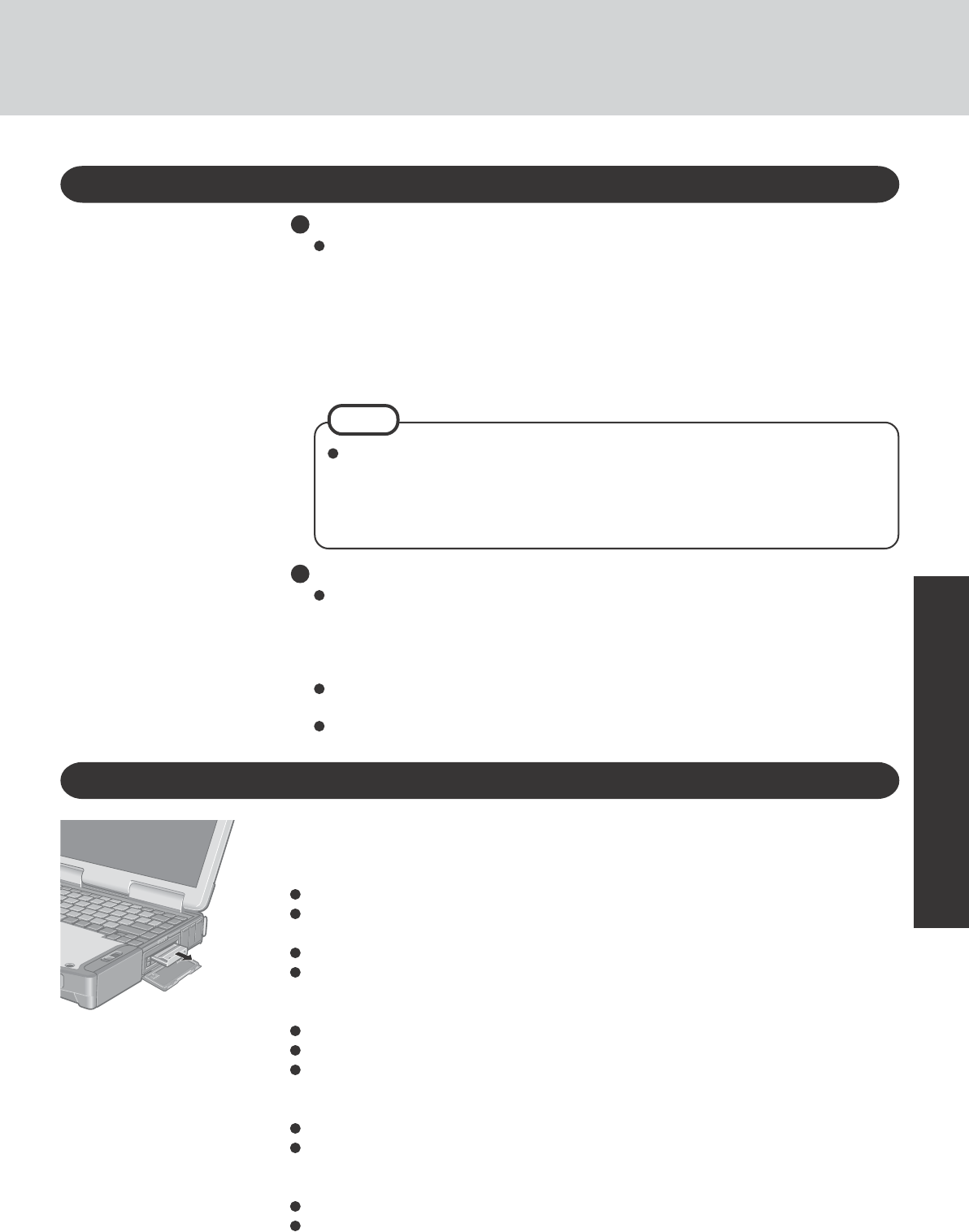
21
Operation
Useful Information
Environment
Operation: Temperature: 5 °C to 35 °C {41 °F to 95 °F}
Humidity : 30% to 80% RH (No condensation)
Storage: Temperature: -20 °C to 60 °C {-4 °F to 140 °F}
Humidity : 30% to 90% RH (No condensation)
Usage Environment
Handling
This computer has been designed so as to minimize shock to the LCD and hard disk drive, the
leakage of liquid (e.g., water) on to the keyboard, etc., but no warranty is provided against such
trouble. Therefore, as a precision instrument, be extremely careful when handling.
When carrying the computer, be sure to keep to the following:
Turn off the computer.
Remove all external devices, cables, and PC Cards sticking out of the computer (see the
figure on the left) before transporting the computer.
Do not drop or hit your computer against solid objects.
Do not place the computer upright or allow it to tip over. When the computer receives
extremely strong shock after falling, the hard disk or floppy disk drive, etc., may become
inoperable.
Do not carry the computer while the display is open, or carry it by gripping the display.
Do not put anything (e.g., a piece of paper) between the display and keyboard.
When taking an airplane, always carry your computer with you. Never check it in with
luggage. Before using the computer inside an airplane, we recommend asking the airlines
regarding their policy on this issue.
Do not leave a disk in the drive while transporting your computer.
When transporting spare batteries inside a package, briefcase, etc., it is recommended that
the batteries be stored in a plastic bag.
We recommend the following:
Preparing a fully charged battery pack (and optional charger, if possible).
Making backup copies on discs and carrying them with you.
NOTE
Only use the computer within the allowable temperature range.
When the computer is left powered on in a low temperature environment, set [Turn off
hard disks] to [Never] in the following menu to avoid damage to the hard disk drive.
[start] - [Control Panel] - [Performance and Maintenance] - [Power Options] - [Power
Schemes]
Places not to use your computer
Such areas may result in damage to the computer.
Areas with electronic equipment
These areas may interfere with your display or cause your computer to produce strange
sounds.
Areas with extremely high/low temperatures
Do not leave things near the computer that are sensitive to heat. During operation, the
computer may become warm.
Before putting the computer away, be sure to wipe off any moisture.
Even within the temperature and humidity ranges noted above, using the computer for
long periods of time in an environment with exceptionally low or high temperatures or
high humidity may result in deterioration of the product, which can lead to a reduction in
product life.

22
Operation
Useful Information
Maintenance
Do not use benzene, thinner, or rubbing alcohol. Doing so may adversely affect the sur-
face, e.g., discoloration. In addition, do not use commercially-available household clean-
ers and cosmetics, as they may contain components harmful to the surface.
Do not directly add or spray water or detergent. If liquid enters the inside of the com-
puter, it may cause it to work improperly or be damaged.
Display
<Models with touchscreen>
Use the Soft Cloth included with the computer. (For more information, refer to “Suggestions
About Cleaning the LCD Surface” that come with the Soft Cloth.)
If the Protective Film becomes damaged, it may be time to replace your Protective Film. The
Protective Film is a disposable item. To find out the model number of your Protective Film,
contact Panasonic Technical Support. (For more information, refer to the “Operating Instruc-
tions” that come with the Protective Film.)
<Models without touchscreen>
Avoid using water when cleaning the panel. Ingredients included in water may leave residue
and reduce readability of the screen.
<When cleaning dust/dirt>
Avoid rubbing off dust/dirt with cloth since it may leave scratch on the screen.
Sweep dust/dirt with fine brush, then wipe it with “dry” soft cloth used for cleaning glasses.
<When cleaning oily surface>
Apply camera lens cleaner on a soft gauze and clean it with gentle force. Then, wipe with dry
soft cloth used for cleaning glasses.
CAUTION
Areas excluding the display
Wipe these areas with a soft cloth, after applying water or detergent diluted with water to the
soft cloth and firmly wringing out excess water.
Do not touch or use a touchscreen before you re-attach a Protective Film, as you may
leave a mark or a scratch on the touchscreen.
CAUTION
Security Center/Antivirus Protection
Use the Windows Security Center function to protect Windows from damage by computer
viruses, etc.
Windows Security Center
What is Windows Security Center?
The Windows Security Center allows centralized management of Windows security infor-
mation, and monitors antivirus measures and other Windows security settings to ensure
optimum safety.
Use the Windows Security Center function to protect your computer from damage by vi-
ruses, etc.
Select [start] - [Control Panel] - [Security Center] to display the current settings for the
following security functions.
• Windows Firewall
A security system for protecting the computer from unauthorized access via the Internet
or other external networks.
The firewall regulates the data exchanged between the computer and the external net-
work, so that only approved data can pass through.
At the time of purchase, the Windows Firewall is set to be enabled.

23
Operation
Saving Data on the Hard Disk
Do not expose your computer to shock.
Use care when handling your computer, shock may damage your hard disk or make your
software applications and data unusable.
Do not power off your computer while software applications are running or hard disk
drive indicator ( ) is on.
Properly shut Windows down to avoid problems.
Save all valuable data to floppy disks, etc.
Backing up data to floppy disks, etc. will limit damage should trouble occur to your com-
puter or should you inadvertently change or erase data.
Use the security function for all important data. ( “Security Measures”)
Hard Disk Lock
When the Hard Disk Lock is set to [Enable], it is impossible to read/write data from/to the
hard disk when the hard disk is installed in a different computer, since a password is also set
for the hard disk. When the hard disk is returned to the original computer, you can read and
write data as before. In this case, however, make the settings in the Setup Utility exactly the
same as they were before the hard disk was removed. (Note that this Hard Disk Lock does
not guarantee complete protection of data.) ( “Security Measures”)
Users are advised to purchase the latest versions of virus protection software and use
them regularly.
We recommend you run the software:
• When booting your computer.
• After receiving data.
We recommend that you check data received on disks or from external sources, such as data
downloaded from the Internet, e-mail, etc. (For compressed files, uncompress them before
running a check).
Computer Viruses
Windows Update
You can use the latest patches and service packs for Windows with the following menus.
Do not apply “Driver Updates” even if a message to update a driver appears. If a driver
update is required, contact to Panasonic Technical Support. ( page 44)
[start] - [All programs] - [Windows Update]
• Automatic Updates
If your computer is connected to the Internet, this function regularly checks whether secu-
rity updates and other important updates have been made available, and automatically
installs these updates in their latest conditions.
• Virus Protection
This function regularly checks whether antivirus software has been installed in the com-
puter, and whether the version of that software is the latest version available.
Read the message, select (red icon) on the taskbar, and make the appropriate settings.
This message, which the Windows Security Center ( page 22) displays to confirm the security-
related settings regularly, will be displayed until the settings are made more properly.
If the message “Your computer might be at risk” is displayed
NOTE
This message does not indicate an error. You can use the computer while the message is
displayed. However, in order to operate the computer more safely, we recommend mak-
ing the appropriate measures to reduce damage from virus and other attacks, thus avoid-
ing the appearance of this message.

24
Operation
When Disposing of or Transferring Ownership of This Device
When disposing of or transferring ownership of this device, erase all data on the hard disk in order
to prevent the theft of hard disk data. Even if you delete data or initialize the hard disk through
normal Windows commands, data can still be read using special software. In order to erase all
data, either have the data erased by a specialist (at a charge) or use the hard disk data erase utility
(included) ( page 41). (Note that this hard disk data erase utility does not guarantee that data
will be completely erased.)
Also, note that if you transfer ownership of this device without deleting commercial soft-
ware that you have installed to the hard disk, you may be in violation of the licensing
agreement for that software.
When Changing Hard Disk Partitions
When using the hard disk backup function, divide the hard disk into partitions when a backup
area is created.( page 37) If you divide the hard disk into partitions before creating the
backup area, the backup area cannot be created.
Useful Information
When Using Peripheral Devices
Pay strict attention to the following points to avoid damage to the computer, peripheral devices,
cables, etc. Also, in addition to following this manual and the Reference Manual, carefully read
the instruction manuals for the peripheral devices being used.
Use only peripheral devices that conform to the computer’s specifications.
Connect the devices properly, paying close attention to the condition and position of the
connectors.
If a connection cannot be made easily, do not apply undue force; check once more to confirm
the condition and position of the connector (alignment of pins, etc.) .
If the connector has holding screws, fasten the screws firmly.
Do not carry the computer with cables attached, and do not pull on the cables forcefully.
To prevent theft of data or unauthorized access to the hard disk
via a wireless LAN.
If you plan to use wireless LAN functions, we recommend that you do so only after making
the appropriate security settings, such as for data encryption.
Wireless LAN (only for models with wireless LAN)
Do not power down your computer or press the disk eject button while the Multimedia
pocket device indicator ( ) is on.
Doing so may damage the data on the floppy disk and render the floppy disk useless.
Use care when handling floppy disks.
To protect the data on your floppy disks or to prevent a floppy disk from becoming stuck in
your computer, avoid the following:
• Sliding the shutter on the floppy disk manually.
• Exposing the floppy disk to a magnetic field.
• Storing the floppy disk in locations prone to high temperatures, low pitched noise, damp-
ness, or dust.
• Applying more than one label on the floppy disk.
Confirm the contents of a floppy disk before formatting it.
Confirm that no important data is on the floppy disk, because all data on the floppy disk will
be erased.
Use the write-protect tab.
This is a must for preserving important data. This prevents your data from being erased or overwrit-
ten.
Saving Data on Floppy Disks
Write Enable
Write Disable
Write-protect Tab
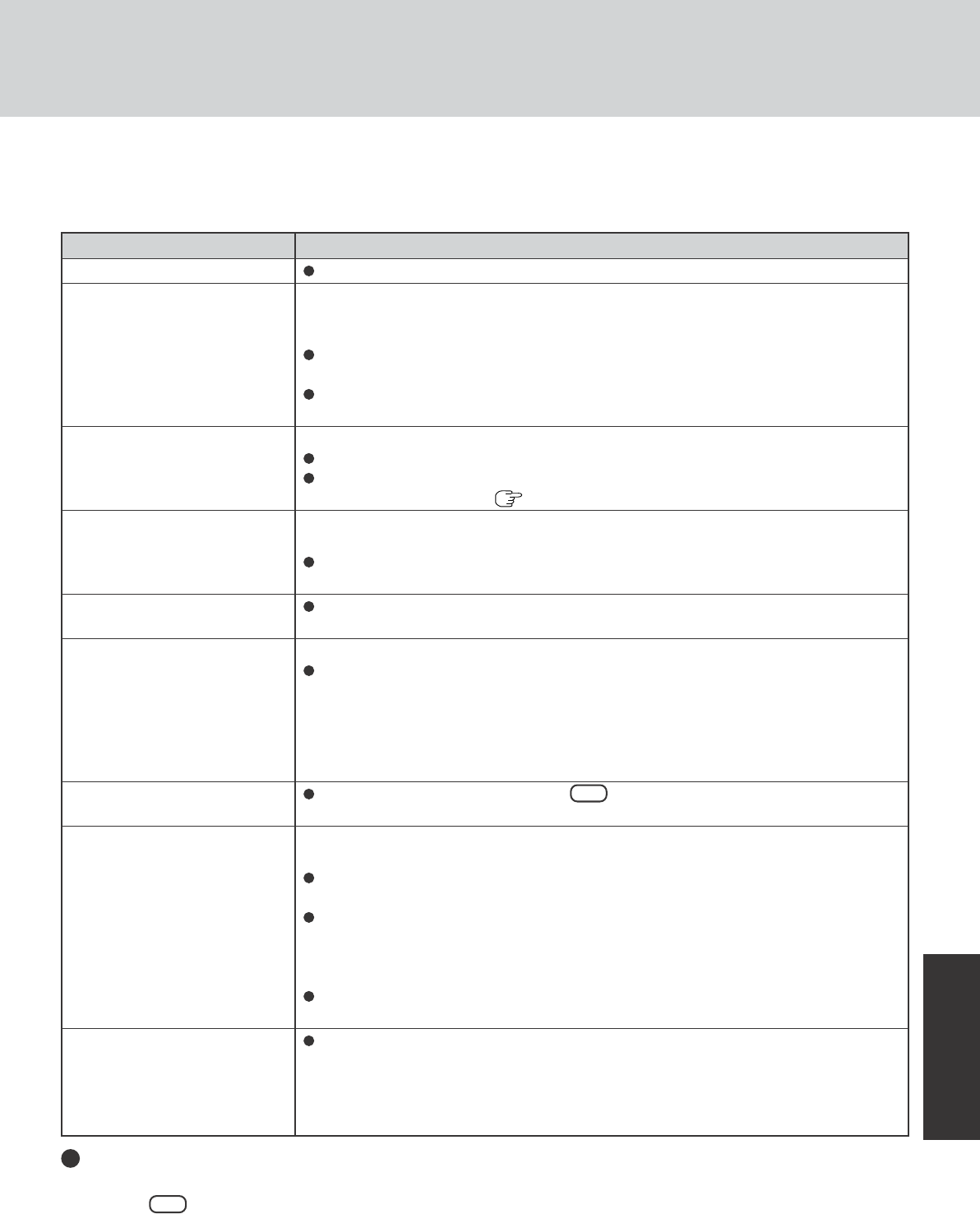
25
Troubleshooting
List of Error Codes
When turning on the computer, if one of the following error codes or messages is displayed, follow the instructions shown below.
If the problem persists, or if the error code or message displayed is not shown here, contact Panasonic Technical Support.
Error Code/Message
0211: Keyboard error
0251: System CMOS checksum
bad - Default configuration used
0271: Check date and time set-
tings
0280: Previous boot incomplete
- Default configuration used
02B0: Diskette drive A error
0613: Serial Port*1 configura-
tion changed
0614: Serial Port*1 config. error
- device disabled
*1The port name, such as A or B, is
displayed, indicating the conflict-
ing ports.
Press <F2> to Setup
Operating System not found
Extended RAM Module Failed
Action
If an external keyboard or mouse is connected, disconnect these devices.
An error has occurred in the memory that stores the Setup Utility settings. This error occurs
when the memory content is changed through some inadvertent operation by a program or
other function.
Run the Setup Utility and load the default values, then change the settings to the appropri-
ate values as needed.
If the problem persists, the internal clock battery may need to be replaced. Contact Pana-
sonic Technical Support.
The data and time setting are incorrect.
Run the Setup Utility and set the date and time correctly.
If the problem persists, the internal clock battery may need to be replaced. Contact Pana-
sonic Technical Support. ( page 44)
Startup has failed repeatedly, so the Setup Utility settings have been returned to their default
values, and the computer has been restarted.
Run the Setup Utility and load the default values, then change the settings to the appropri-
ate values as needed.
Disconnect the floppy disk drive and reconnect it. Make sure the drive is secured cor-
rectly.
I/O address and IRQ settings are in conflict.
Run the Setup Utility and change the settings in [Advanced] menu so there is no port
conflicts.
Write down the error details and press F2 to run the Setup Utility. Confirm the settings,
and change the settings to the appropriate values as needed.
The OS is not properly installed on the floppy disk or the hard disk that you are trying to boot
from.
If the computer cannot be booted from the floppy disk, check the floppy disk drive to
ensure that the disk is in fact bootable, and change it to another if not.
If the computer cannot be booted from the hard disk, confirm whether the hard disk is
properly recognized in [Information] menu of the Setup Utility.
• If the hard disk is recognized, perform the reinstallation procedure.
• If not, contact Panasonic Technical Support.
If a device is connected to the USB port, disconnect the device, or run the Setup Utility
and set [Legacy USB Support] in [Advanced] menu to [Disable].
If the extended RAM module has not been inserted properly, or if an extended RAM
module other than one matching the specifications has been inserted, a beep will sound
and the message “Extended RAM Module Failed” will be displayed when turning the
power on. In this case, turn the power off, confirm that the extended RAM module meets
the specifications, and reinsert it.
To run the Setup Utility
1Restart the computer.
2Press F2 while [Panasonic] boot screen is displayed soon after the computer begins the startup procedure.
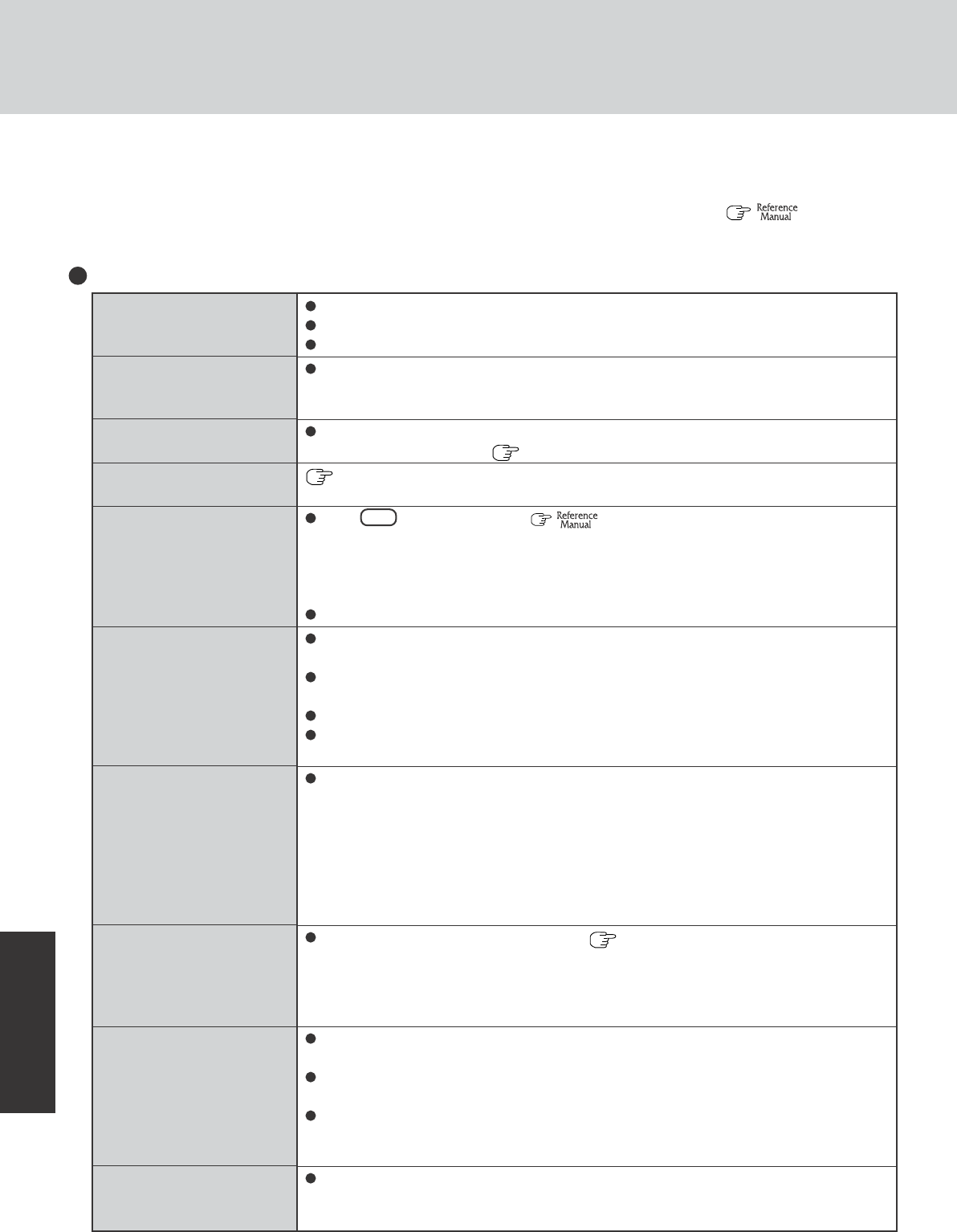
Troubleshooting
26
The power indicator or bat-
tery indicator is not lit
The computer does not op-
erate when a USB device is
connected
[Enter Password] is dis-
played
POST Startup Error(s) is
displayed
Windows startup, or an op-
eration is extremely slow
The date and time are incor-
rect
When resuming from the
standby or hibernation
mode, [Enter Password]
does not appear even if a
password has been set in the
Setup Utility
When the administrator
password is forgotten
When “Remove disks or
other media. Press any key
to restart” (or a similar mes-
sage) is displayed
[Executing Battery
Recalibration] screen is dis-
played
When a problem occurs, refer to this page. The “Reference Manual” also contains detailed information. If a problem appears to be
related to a software application, read the software related manual. If you still cannot troubleshoot the problem, contact Panasonic
Technical Support. You can use the PC Information Viewer to check the computer’s usage status. ( “Dealing with
Problems (Advanced)”)
Dealing with Problems (Summary)
Starting Up
Check the cable connection for the AC adaptor.
Check to see if a fully charged battery is properly installed.
Remove the battery pack and disconnect the AC adaptor, then connect them again.
The computer may not operate when certain USB devices are connected. Disconnect the
USB device, or set [Legacy USB Support] to [Disable] in [Advanced] menu of the Setup
Utility.
Input your Supervisor Password or User Password. If you have forgotten it, contact Pana-
sonic Technical Support. ( page 44)
page 25
Press F9 in the Setup Utility ( “Setup Utility”). This will restore the Setup
Utility’s settings to their default values (except the password settings). Then, the Setup
Utility must be run once again for you to input the appropriate operating environment
settings. (The processing speed depends on the application software used, so this opera-
tion may not cause the processing speed to increase.)
If you install resident software after purchasing this computer, disable the resident software.
You can set the date and time using the following menu.
[start] - [Control Panel] - [Date, Time, Language, and Regional Options] - [Date and Time]
If you continue to experience problems, the internal battery maintaining the clock may
need to be replaced. Contact Panasonic Technical Support.
When the computer is connected to a LAN, confirm the date and time of the server.
This computer will not correctly recognize the date and time starting from the year 2100
A.D.
Even when a password has been set in the Setup Utility, [Enter Password] does not appear
when the computer resumes from the standby or hibernation mode.
If you want to use the security function when using the standby or hibernation mode, use
the Windows password as follows:
1Select the account to change in [start] - [Control Panel] - [User Accounts] and set the
password.
2Add the check mark for [Prompt for password when computer resumes from standby]
in [Control Panel] - [Performance and Maintenance] - [Power Options] - [Advanced].
If you have created a password reset disk ( page 15), a message is displayed when you
fail to correctly enter the password. Follow the message’s instructions and set the pass-
word again by using the password reset disk.
If you have not created a password reset disk, after reinstalling, setup Windows and then
set the password again.
This means a floppy disk that does not contain system startup information has been left in
the floppy disk drive. Remove the floppy disk, and press any key.
This message may appear when certain USB devices are connected. Remove the USB de-
vice, or set [Legacy USB Support] in [Advanced] menu of the Setup Utility to [Disable].
If the message still appears even after trying the above two measures, this may be an
indication that some type of hard disk failure has occurred. Contact Panasonic Technical
Support.
This screen appears because the Battery Recalibration was canceled before Windows was
shut down last. To start up Windows, turn off the computer by sliding the power switch,
and then turn it back on again.
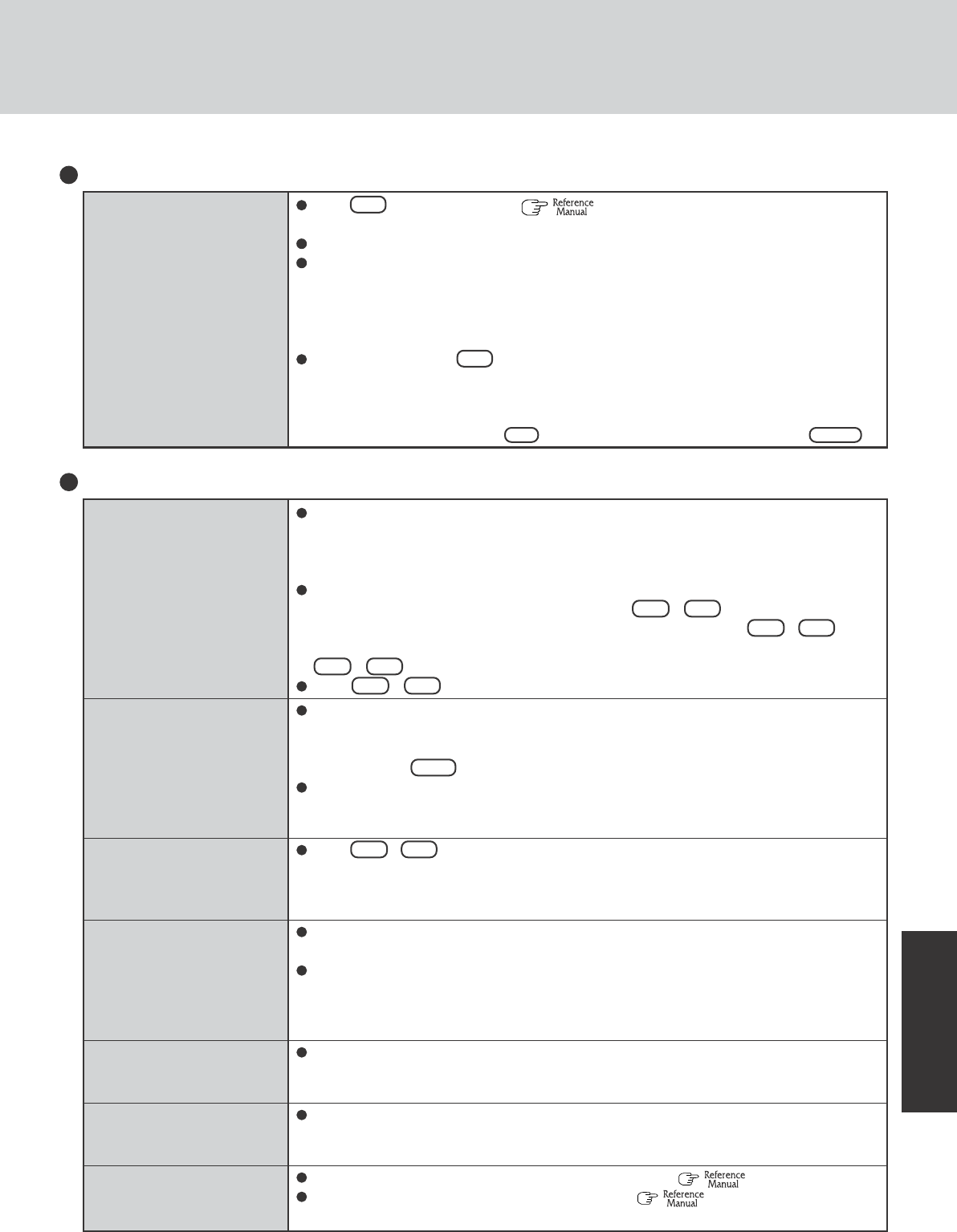
27
Troubleshooting
When the previous item is
not the cause
Starting Up (continued)
Press F9 in the Setup Utility ( “Setup Utility”). This will restore the Setup
Utility’s settings to their default values (except the password settings).
Try removing all peripheral devices.
Check a disk error using the following procedure.
1Select [Local Disk(C:)] with the right button in [start] - [My Computer], and select
[Properties].
2Select [Tools] - [Check Now].
3Select [Start] after selecting required items in [Check disk options].
At startup, hold down F8 when [Panasonic] boot screen disappears*1, and release your
finger when the Windows Advanced Options Menu is displayed. Start the computer in
Safe Mode, and confirm the details of the error.
*1When [Password on boot] is set to [Enable], [Enter Password] appears after the [Panasonic] boot
screen disappears. Hold down F8 soon after inputting the password and pressing Enter .
No display after powering on
The power has not been
turned off, but after a cer-
tain period of time, there is
no display
When the battery pack is
used, the screen is darker
than when the AC adaptor
is connected
An afterimage appears (e.g.,
green, red, and blue dots re-
main on the display) or there
are dots not displaying the
correct colors
The screen becomes disor-
dered
The external display no
longer displays properly
When you want to display
the fonts or icons at a larger
size
When there is no display to an external display,
• Check your cable connection to the external display.
• Confirm your display is powered on.
• Check the settings for your external display.
The display destination may be set to the external display.
Try changing the display destination by pressing Fn + F3 .
If you want to switch the display destination repeatedly by pressing Fn + F3 , make
sure that the display destination has switched completely each time before pressing
Fn + F3 again.
Press Fn + F2 and adjust the brightness.
Has the computer been set to the power-saving mode?
To resume operation of your computer from the condition the power of the display is off
(for energy conservation purposes), press any key unrelated to the direct triggering of a
selection, like Ctrl .
To save power, your computer may have automatically entered the standby mode (power
indicator blinks green) or hibernation mode (power indicator turns off). In such cases,
slide the power switch.
Press Fn + F2 and adjust the brightness. Note, however, that when the brightness is
increased, the battery running time will become shorter.
Brightness can be set to separate levels for when the AC adaptor is connected and when it
is disconnected.
If an image is displayed for a prolonged period of time, an afterimage may appear. This is
not a malfunction. The afterimage will disappear when a different screen is displayed.
High-precision and advanced technologies are necessary in the production of color liquid
crystal displays (color LCDs). Therefore, if 0.002% or less of the picture elements either
fail to light or remain constantly lit (that is, more than 99.998% of elements are function-
ing properly), no defect is considered to exist.
The screen display may become distorted if the resolution or number of colors is changed,
or if an external display is connected or disconnected while the computer is operating.
Restart the computer.
When an external display not compatible with the power saving mode is used with the
computer, the display may not function correctly when the computer enters the power
saving mode. In such cases, turn off the power to the external display.
Change the size of the icons, etc. using “Icon Enlarger” ( “Icon Enlarger”).
To enlarge a part of the screen, use Loupe Utility ( “Loupe Utility”).
Display
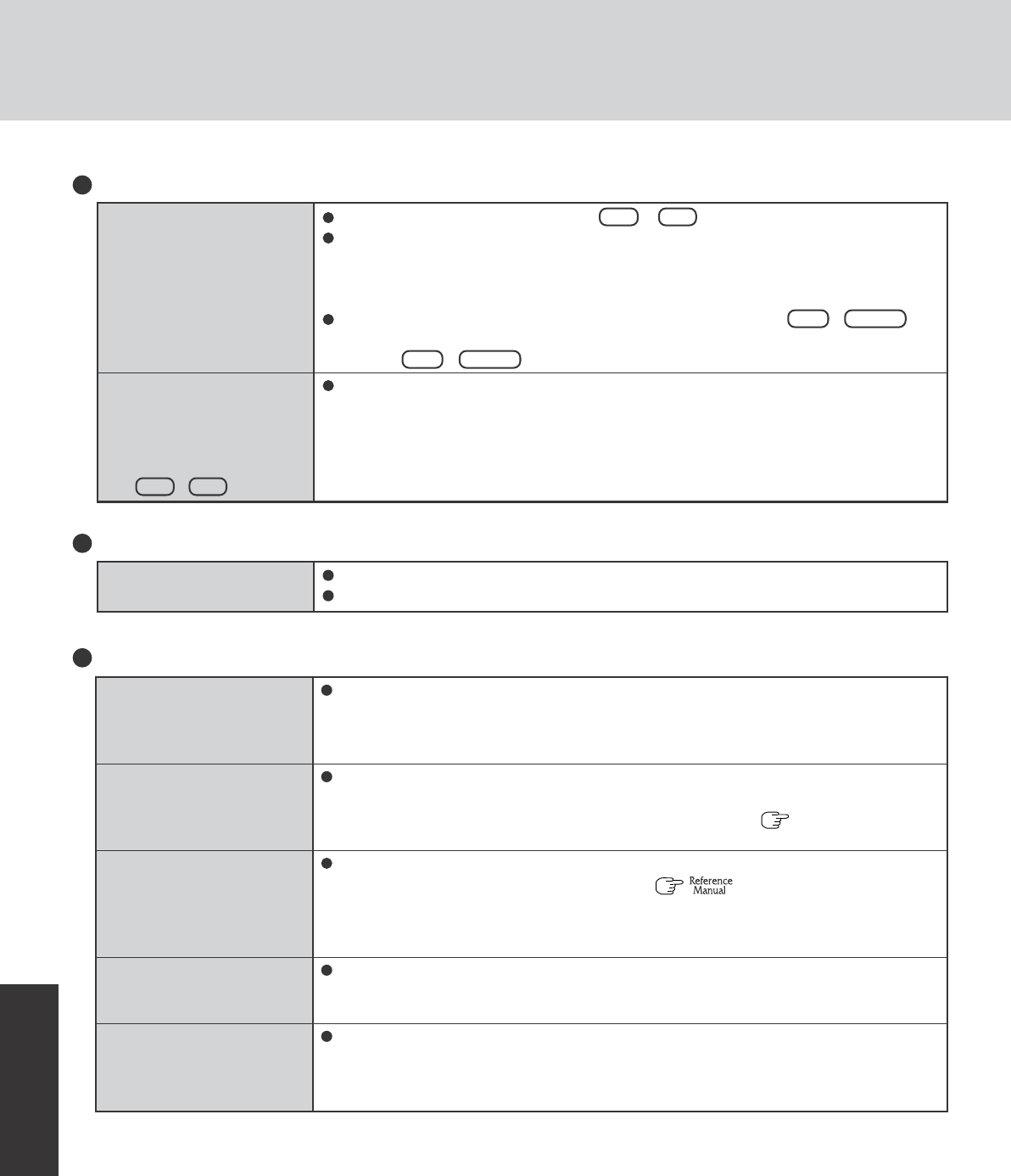
Troubleshooting
28
Dealing with Problems (Summary)
During simultaneous dis-
play, one of the screens be-
comes disordered
When an a moving picture
such as an MPEG file is be-
ing played with Media
Player, the display destina-
tion cannot be switched us-
ing Fn + F3
Try changing the display by pressing Fn + F3 .
If you continue to experience problems, try changing the display destination in the follow-
ing menu.
[start] - [Control Panel] - [Other Control Panel Options] - [Intel(R) Extreme Graphics 2
M] - [Devices]
When the [Command Prompt] is set to “Full Screen” by pressing Alt + Enter , the
picture is displayed on one of the screens only. When the window display is restored by
pressing Alt + Enter , the picture is displayed on both screens.
The display destination cannot be switched while a moving picture such as an MPEG file
is playing. Stop playing the moving picture before switching the display destination.
Display (continued)
Windows cannot be shut
down or restarted
Shutting Down
If a USB device is connected, try removing it.
It may take one or two minutes to shutdown.
Battery Indicator
The red indicator lights.
The red indicator blinks
The green indicator blinks
The battery indicator blinks
green and orange alternately
The orange indicator blinks
The battery level is very low (the charge is approx. 9% or less).
Connect the AC adaptor. You can use the computer when the battery indicator light is
orange. If you do not have an AC adaptor, save your data and power off your computer.
After replacing the battery pack with a fully charged one, turn your computer on.
Quickly save your data and power off your computer. Remove the battery pack and dis-
connect the AC adaptor, then connect them again.
If the problem persists, contact Panasonic Technical Support. ( page 44) The battery
pack or charging circuit may be defective.
In high temperature mode, the battery is discharging to the level that corresponds to an
80%*1 charge for normal temperature mode. ( “Battery Power”) Do not re-
move the battery pack while the battery indicator is blinking green.
*1 In high temperature mode, the level that corresponds to an 80% charge for normal temperature
mode is displayed as [100%].
Warming up the system to prevent hard disk drive malfunctions at low temperature. Leave
your computer as is. Once the allowable temperature range requirement is satisfied, your
computer will start automatically.
Battery cannot be recharged temporarily because the internal temperature of the battery
pack is outside of the acceptable temperature range for recharging. Once the allowable
range requirement is satisfied, charging begins automatically. Your computer can be used
normally in this state.
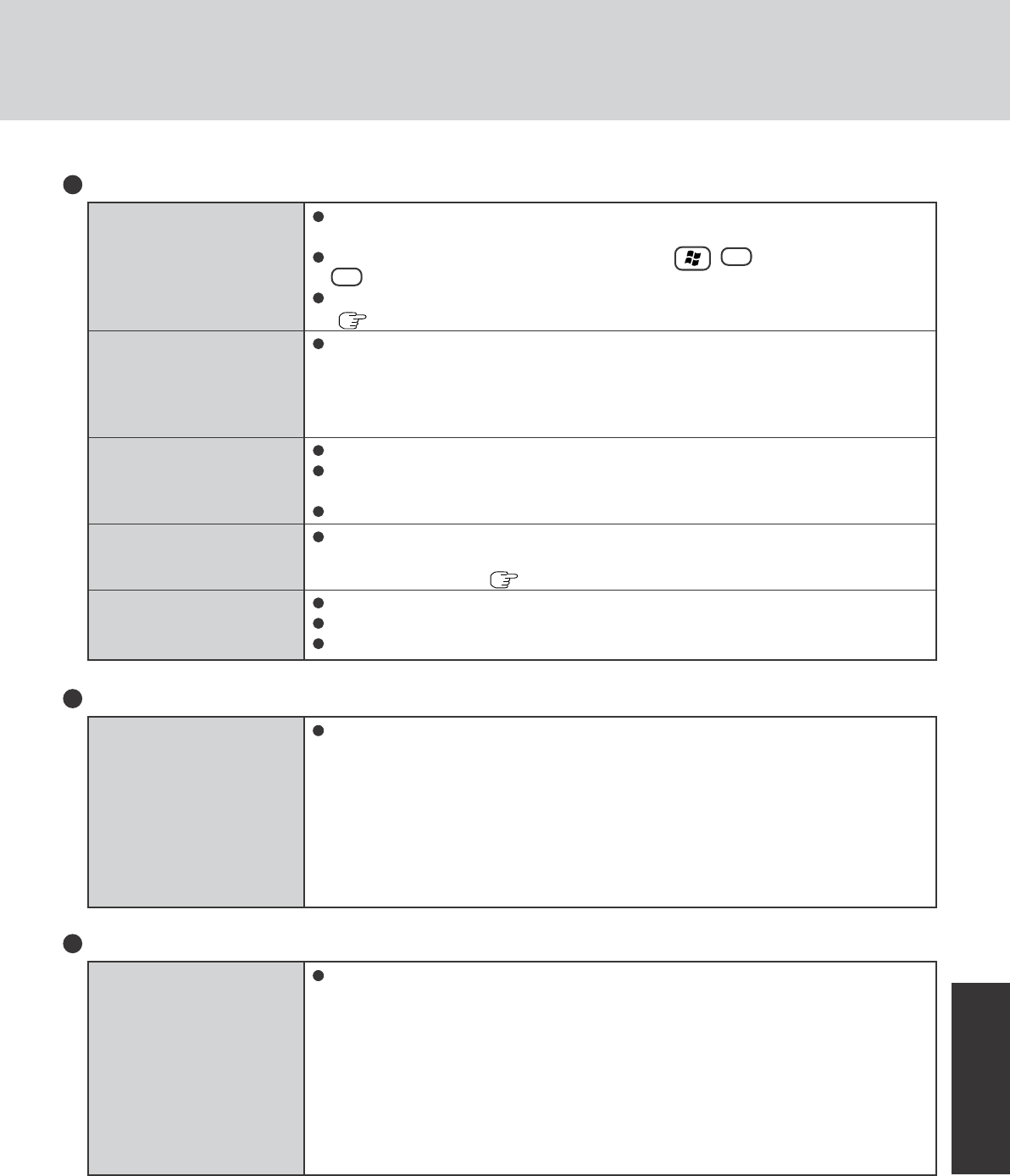
29
Troubleshooting
Touch Pad / Touchscreen (only for models with touchscreen)
If you are using an external mouse, ensure that the external mouse has been connected
correctly.
Restart the computer by using the keyboard (Press , U , and select [Restart] with
R ).
If the computer does not respond to keyboard commands, read “No response”
( page 30).
When the Microsoft® IntelliMouse™ Wheel mode or the original mode is set for the touch
pad, only scroll operations are possible for the right part or bottom part of the touch pad.
In this case, cursor operations are possible by using the work surface excluding the right
part or bottom part. When no mode is set, the entire surface of the touch pad can be used
for cursor operations.
Has the Setup Utility been used to set [Touch Pad] to [Enable]?
When external mouse drivers are installed (e.g., Intellimouse), the touch pad may not be
used.
Has the touch pad driver been properly installed?
As a result of the physical characteristics of the touchscreen, sometimes the position of the
stylus does not match the position of the cursor on the screen. This is not a malfunction.
Perform [Calibration] ( page 13).
Has the Setup Utility been used to set [Touchscreen] to [Enable]?
When mouse drivers are installed (i.e. IntelliMouse), the touchscreen is unable to be used.
Has the touchscreen driver been properly installed?
The cursor cannot be con-
trolled properly
The cursor does not move in
scrolling area of the touch
pad
Unable to input using the
touch pad
Unable to point correctly
with the stylus included with
the computer
Unable to input by touching
the display
The Reference Manual is
not displayed
Is Adobe Reader installed?
If you have uninstalled Adobe Reader, install using the following procedures.
1Select [start] - [Run], input [c:\util\reader\AdbeRdr60_enu_full.exe], then select [OK].
Install Adobe Reader by following the instructions on the screen.
2Update Adobe Reader to its latest version.
If your computer is connected to the Internet, start up Adobe Reader and select [Help]
- [Update].
If your computer is not connected to the Internet, select [start] - [Run], input
[c:\util\reader\Acro-Reader_6.0.2_Update.exe], then select [OK].
Reference Manual
Some applications may not
work properly
When switching to a different user with the Fast User Switching function, the following
problems may occur.
• Some applications may not work properly.
• Key combinations with the Fn key may not work.
• It may not be possible to set the settings of the display.
• A serial mouse may not work.
• <Only for models with wireless LAN>
Wireless LAN may not work.
In this case, log off all users without using Fast User Switching function, and try the
operation once more. If the problem persists, restart the computer.
Fast User Switching function
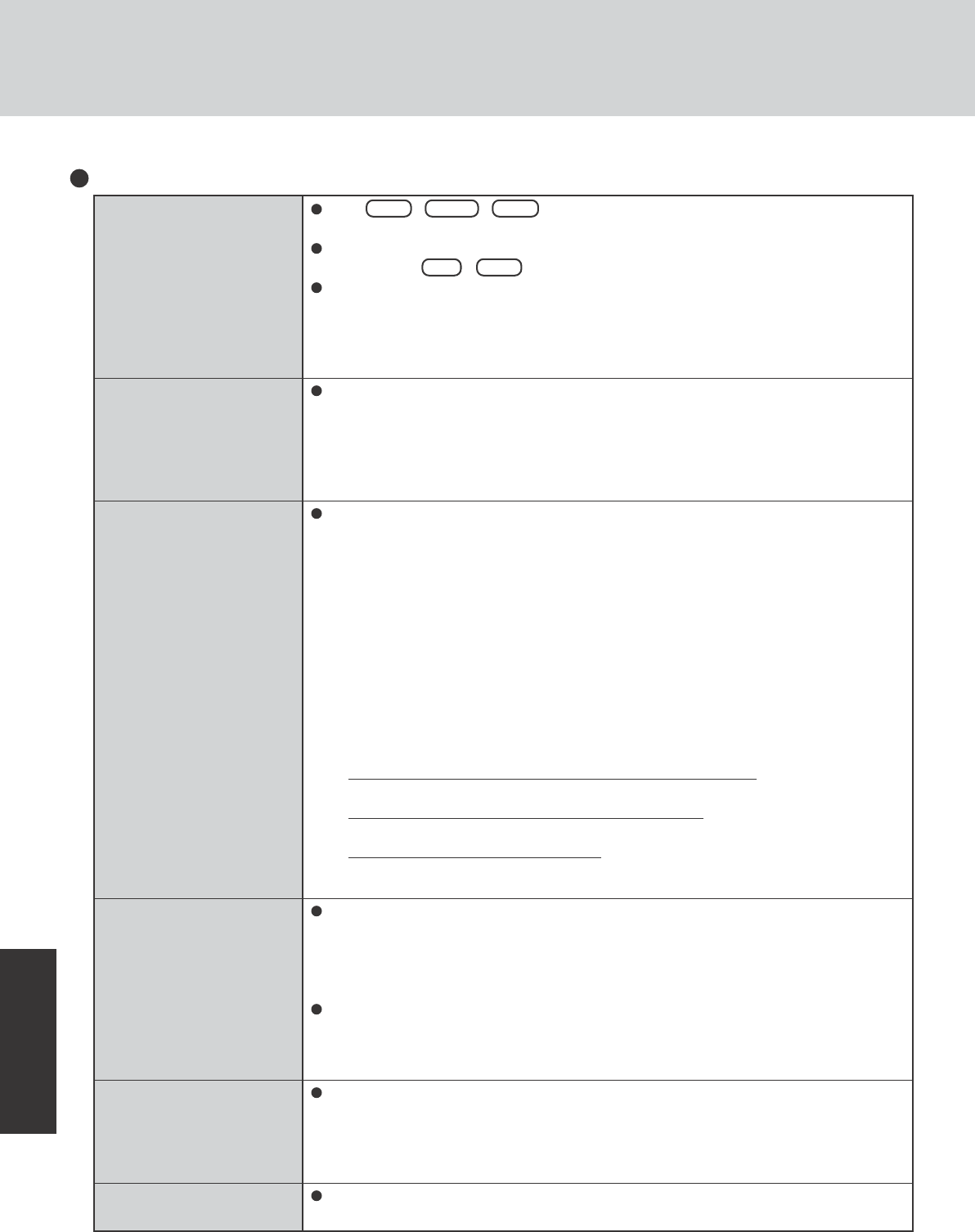
Troubleshooting
30
Dealing with Problems (Summary)
Others
Press Ctrl + Shift + Esc to open Task Manager and close the software application
which is not responding.
Is there an input screen (e.g., password input screen at startup) hidden behind another
window? Use Alt + Tab to check for other windows being displayed.
After shutting down by sliding the power switch for more than four seconds, slide the
power switch to power on and open the application again.
If the program no longer works normally, delete the program using the following menu.
Then reinstall the program.
[start] - [Control Panel] - [Add or Remove Programs]
Some video files use a Codec that is not installed as a standard. In these cases, if you play
back the video file after connecting to the Internet, the Codec may be downloaded auto-
matically, allowing you to play back the file.
If you cannot start up a program or share files, this may be because the “Firewall (Win-
dows Firewall)” in the “Windows Security Center” is set to be enabled.
If this function is set to be enabled, damage from viruses and other attacks is reduced, but
some programs and functions cannot be operated.
To use the program or to share files or printers:
You can use programs or other functions without the effects of the Windows Firewall by
registering them as an exception in the Windows Firewall settings (it is not necessary to
disable the Windows Firewall).
Note, however, that if a program is registered as an exception, there is a risk of damage
from viruses or other attacks. Before registering a program as an exception, confirm the
program’s safety with the manufacturer or other reliable source.
1Select [start] - [Control Panel] - [Security Center] - [Windows Firewall].
2Select [Exceptions].
3To register a network game or other programs as an exception:
Select [Add Program], select the program, and select [OK].
To set access through a specified port as an exception:
Select [Add Port], set the port, and select [OK].
To set a file or printer as an exception:
Add the check mark for [File and Printer Sharing].
4Confirm that there is a check mark for the item to be set as an exception, and select [OK].
The Windows Firewall is a security function designed to protect your computer from
unauthorized access via the Internet and other external networks.
The firewall regulates the data exchanged between the computer and the external network,
so that only approved data can pass through. We recommend that you use your computer
with the Firewall enabled to minimize damage from viruses and other malicious attacks.
When installing additional commercially available firewall software, we recommend that
you disable the Windows Firewall settings, as the new software may interfere with the
Windows Firewall functions.
For details, refer to the manual accompanying the firewall software to be installed.
Only Windows Update programs with a high level of priority will be automatically down-
loaded (or installed).
Update programs with a comparatively low level of importance will not be downloaded
(or installed) automatically. Check regularly whether new update programs have become
available.
The Security Center warning function will not operate if you are using a network domain,
for example at a company.
No response
When trying to play back
video files using Windows®
Media Player, the message
[Codec required] appears,
and the file cannot be played
back
Cannot start a network-
used program, or cannot
share files or printers
Is it necessary to enable the
Windows Firewall?
When “Automatic Updates”
is enabled, will all updates
be downloaded (or in-
stalled)?
Security Center warning
function does not operate